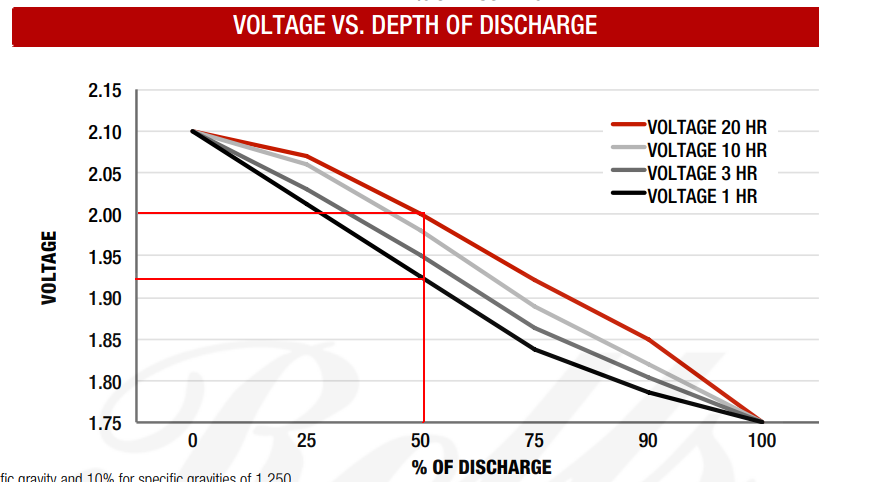I know you can’t check the state of charge of a battery based on voltage and therefore one should go by the SOC on the Victron, but I always have trouble believing the Victron when, for example it says SOC is 75% and voltage is 12.15 (I’m assuming 12.2 to be the 50% point). My question is: in a 12V system, what range of voltage should one not be surprised at when the SOC is 50%? In my example, should I just blow through 12.1V and only look at SOC or should I be concerned that something isn’t right? I’ve had the Victron for years and I never go by SOC because of that issue……so why have the Victron if I can’t believe it!
- Home
- Anonymous
- Sign in
- Create
- Spaces
- Grafana
- Node-Red
- Unsupported topics
- Questions & Answers
- Modifications
- Communauté francophone
- Deutschsprachiger Bereich
- Preguntas en Español
- Explore
- Topics
- Questions
- Ideas
- Articles
- Badges
question
Trying to believe SOC but voltage is lower than I would expect
What is "the Victron"? I guess a BMV or SmartShunt?
What type of battery?
Settings of "the Victron"?
Victron BMV - 700
3x group 27 lead acid batteries in parallel
Mounted in a boat
Settings:
Bat Cap: 327
Charge Voltage: 13.2
Tail current: 0.5
Peukert: 1.2
efficiency: 85%
No load current: 0
Let me know if you want more info.
So, the direct question is if the SOC is 50% for example, what is the voltage that would look out of line and unexpected - 12.1, 12.0, 11.5, 11.0, etc? I recognize that the voltage really is meaningless unless there has been no load for a time, but after using 12.2 volts as a lower limit for so many years, it’s tough to teach old dogs new tricks!
How low you can go depends on the battery age, brand, capacity, type (AGM, FLA, GEL), battery temperature and the C rate. The Victron shunts consider Peukert, so they're more accurate than most when using higher than C20 current.
Completely cutting off the battery for 24 hours is impractical, but that will get you an accurate voltage to SoC reading.
Even cutting the load/charge for 15-30 minutes, you can get a small bounce and a better idea of voltage indicated SoC, though it's still conservative.
Unfortunately, as an old dog, you're going to have to learn this new trick. There's no answer for your question. Back in my FLA days, I confirmed it by periodically (every few months) cutting off the system for 2 hours and approximated the SoC based on voltage.
Let me ask it this way: If YOUR system showed 75% SOC and 12.1V would you blindly use another 25% until the SOC is 50%?
I understand there are a lot of variables. I just don’t have the confidence to take the voltage too low beyond 12.1 or 12.0 since, apparently there can be physical damage to the battery at that level.
So how confident are you of your system that you would only look at the SOC?
You keep trying to find ways to not learn the new tricks! :)
It depends on the battery, the temperature and the load. I've regularly run below 12V. I have this information from Rolls on my 2S2P S-605 bank:

For my batteries, RESTING voltage after 20 hours of 12.0V indicates 50%.
After 1 hr, it's 11.52V.
So, if SoC is indicating 50%, and I'm above 11.52 under load, I KNOW the battery is above 50%.
Temperature is also a key factor. You get less out of a cold battery. Since you're using a 700 and not a 702 or 712, you don't have any temperature data. You'd have to make a mental adjustment based on the temperature efficiency of your brand, or a generic value if specific is unavailable. You lose about 25% capacity at freezing.
There's also this spectre of "you're going to damage your batteries if you use more than 50%." This is false. Most batteries will reliably cycle down to 20% SoC, but it does reduce the number of cycles you get. I've deliberately tested batteries down to 0% to confirm their capacity and then go put them in service for years.
Lots of variables!
Measuring SoC using voltage requires zero load on the batteries for a period of time before measuring, basically when you remove the load the voltage will slowly climb and you need to wait until it has stabilised.
You also need to take into account the temperature of the batteries and the chemistry type (gel, AGM, flooded etc) and even these vary a little between different brands.
So as you already know, given these issues, it's not regarded as a very accurate method of measuring SoC. My suggestion is get a SmartShunt!
Guy
Related Resources
Additional resources still need to be added for this topic
question details
37 People are following this question.
